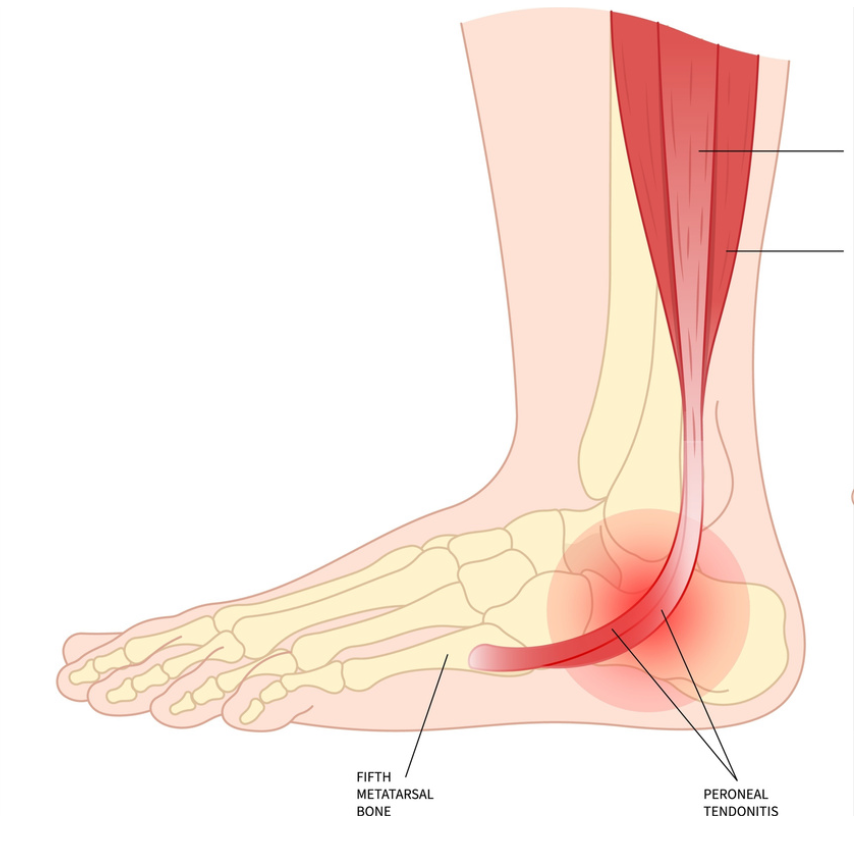Peroneal Tendon Conditions
What are Peroneal Tendon Conditions?
There are two peroneal tendons: the peroneus brevis and the peroneus longus. They function together on the outside of the ankle to help stabilise it during side-to-side movement and uneven ground. The peroneal tendons are prone to tearing due to ‘wear and tear’, overuse and biomechanics. Over time, the tendons become more worn, which leads to degenerative tears, inflammation and pain. An injury can also cause an acute tear or make the tearing worse. The instability of the tendons can also make the tearing and pain worse.

Impact of Peroneal Tendon Conditions on Anatomy and Health
Peroneal tendon conditions can significantly affect your mobility, stability, and overall quality of life by:
- Ankle Instability: Damage or dysfunction in the peroneal tendons compromises their ability to stabilise the ankle, making it prone to rolling or sprains.
- Pain and Discomfort: Inflammation or tearing of the tendons can lead to chronic pain, particularly during movement.
- Altered Gait: To compensate for pain or instability, individuals may change their walking pattern, potentially leading to additional strain on other joints and muscles.
- Decreased Athletic Performance: Athletes, especially runners and dancers, often experience difficulty performing due to reduced ankle strength and mobility.
- Long-Term Complications: If left untreated, conditions like tendon tears or chronic inflammation may result in permanent damage, including arthritis or deformities in the foot structure.
Risk Factors for Peroneal Tendon Conditions
Certain factors may increase the risk of peroneal tendon conditions, such as:
- Ankle instability and giving way
- Foot shape such as a high arch
- Tendon instability
- Previous fractures or injuries in the area
Symptoms of Peroneal Tendon Conditions
- Tendon Instability: Peroneal tendon instability presents with pain, swelling and/or clicking on the side of the ankle. The tendon can be seen to ‘jump out’ of its groove behind the fibula bone. This can lead to tears.
- Tendon tears: Peroneal tendon tears present with
- Pain or swelling at the side of the ankle
- It can be associated with giving way or instability, especially on uneven ground.
- Rarely, the tendon can rupture and cause acute pain
Prevention of Peroneal Tendon Conditions
While not all peroneal tendon conditions can be prevented, you can reduce the risk through the following measures:
Strengthening and Conditioning
- Perform exercises to strengthen the ankle, foot, and leg muscles, particularly the peroneal muscles. Physiotherapy can often help with this.
- Include balance and proprioception exercises to improve stability and reduce the risk of ankle injuries.
Proper Footwear
- Wear supportive shoes that provide adequate arch support and cushioning.
- Avoid high heels or unsupportive footwear that may strain the tendons.
Gradual Progression in Activities
- Increase physical activity levels gradually to avoid overloading the tendons.
- Allow sufficient time for rest and recovery, especially after intense exercise.
Stretching and Warm-Up
- Stretch the calf muscles, Achilles tendon, and peroneal muscles before engaging in physical activities.
- Warm up properly to prepare the tendons for movement and reduce stiffness.
Avoid Overuse
- Alternate between activities to prevent repetitive strain on the tendons.
- Incorporate cross-training to reduce the risk of overuse injuries.
Manage Risk Factors
- Address biomechanical issues such as flat feet or high arches with orthotics or custom insoles. Podiatrists can often help with this.
- Seek treatment for any ankle injuries promptly to prevent long-term complications.
Listen to Your Body
- Pay attention to early signs of pain or discomfort and take action to address them.
- Avoid pushing through pain, as this can exacerbate the condition.
Types of Peroneal Tendon Conditions
Peroneal tendon conditions encompass several distinct issues, each with unique characteristics and causes. The main types include:
- Peroneal Tendonitis: Inflammation of the peroneal tendons caused by overuse or repetitive stress.
- Peroneal Tendinosis: Degeneration of the tendon tissue over time due to chronic overuse without proper healing.
- Peroneal Tendon Subluxation/Dislocation (tendon instability): The tendons slip out of their normal groove behind the outer ankle bone due to trauma or a loose retinaculum (the ligament holding the tendons in place).
- Peroneal Tendon Tears: A partial or complete rupture of the tendon fibres.
- Peroneal Tenosynovitis: Inflammation of the sheath surrounding the tendons, often associated with tendonitis.
Stages of Peroneal Tendon Conditions
The progression of peroneal tendon conditions typically occurs in stages, depending on the severity and duration of the issue:
- Acute Stage: The initial phase, marked by sudden pain and inflammation.
- Subacute Stage: The phase where inflammation begins to subside, but the tendon may still be weakened or damaged.
- Chronic Stage: A long-term phase characterised by tendon degeneration (tendinosis) or recurring issues due to improper healing or continued stress.
Diagnosis of Peroneal Tendon Conditions
Diagnosis typically involves reviewing the patient’s history and clinical ankle examination. Imaging is required, such as:
- X-Rays and ultrasound
- MRI is the gold standard and is often ordered by the specialist
Management and Treatment of Peroneal Tendon Conditions
Depending on the severity of the pathology, some patients will improve with non-operative
management.
Options include:
- Anti-inflammatory medication: Ibuprofen should be taken in short courses and with meals, as it can irritate the belly
- Modified Footwear: Supportive boots can help with side-to-side movement of the ankle
- Podiatry and/or physiotherapy: Strengthening and stretching can help with symptoms, and an ankle brace helps support the ankle. Orthotics can help with high arches or foot shape.
- Injections: Targeted injections can help with the diagnosis and help reduce the inflammation
- Surgery: For severe cases not responding to non-operative management, surgical intervention may be necessary. Tears <50% of the tendon can be debrided, but tears >50% of the tendon are usually not repairable, and the tendons need to be repaired to each other. If both tendons are badly torn, a tendon graft may be required. (see Peroneal Tendon Surgery). Instability of the peroneal tendons requires surgical stabilisation of the tendons behind the fibula.
What if Peroneal Tendon Conditions are Untreated?
Neglecting treatment for peroneal tendon conditions can lead to several complications and long-term consequences:
- Chronic Pain
- Tendon Rupture
- Ankle Instability
- Altered Gait and Biomechanics
- Structural Deformities
- Arthritis
- Reduced Quality of Life
- Need for Surgery
Useful Websites
Contact Us
If you want more information or have any questions or problems, please contact Dr Graff at admin@christygraff.com or call the rooms at 0493 461 133.
